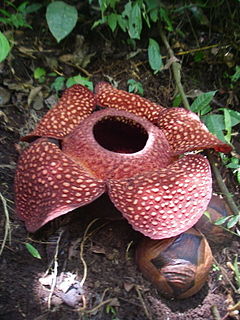
Rafflesia is a genus of parasitic flowering plants in the family Rafflesiaceae. It contains approximately 28 species, all found in Southeast Asia, mainly in Indonesia, Malaysia, Thailand and the Philippines. To Western Europe, it was first discovered by French surgeon and naturalist Louis Deschamps in Java between 1791 and 1794, but his notes and illustrations, seized by the British in 1803, were not available to western science until 1861. It was later found in the Indonesia rainforest in Bengkulu, Sumatra by an Indonesian guide working for Joseph Arnold in 1818, and named after Sir Stamford Raffles, the leader of the expedition.

Antique is a province in the Philippines located in the Western Visayas region. Its capital is San Jose de Buenavista, the most populous town in Antique. The province is situated in the western section of Panay Island and borders Aklan, Capiz and Iloilo to the east, while facing the Sulu Sea to the west.

Rafflesia kerrii is a member of the genus Rafflesia. It is found in the rainforest of southern Thailand and peninsular Malaysia, with the most famous population in the Khao Sok National Park. The local Thai names are Bua Phut (บัวผุด), Yan Kai Tom (ย่านไก่ต้ม) and Bua Tum (บัวตูม).
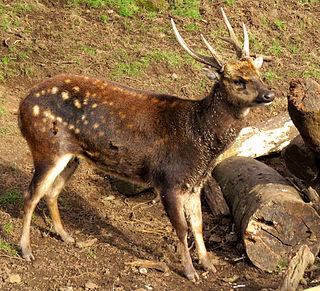
The Visayan spotted deer, also known as the "Philippine spotted deer" or "Prince Alfred's deer", is a nocturnal and endangered species of deer located primarily in the rainforests of the Visayan islands of Panay and Negros though it once roamed other islands such as Cebu, Guimaras, Leyte, Masbate, and Samar. It is one of three endemic deer species in the Philippines, although it was not recognized as a separate species until 1983. An estimated 2,500 mature individuals survived worldwide as of 1996, according to the IUCN, although it is uncertain of how many of them still survive in the wild. The diet of the deer, which consists of a variety of different types of grasses, leaves, and buds within the forest, is the primary indicator of its habitat. Since 1991 the range of the species has severely decreased and is now almost co-extensive with that of the Visayan warty pig.

The Rafflesiaceae are a family of rare parasitic plants comprising 36 species in 3 genera found in the tropical forests of east and southeast Asia, including Rafflesia arnoldii, which has the largest flowers of all plants. The plants are endoparasites of vines in the genus Tetrastigma (Vitaceae) and lack stems, leaves, roots, and any photosynthetic tissue. They rely entirely on their host plants for both water and nutrients, and only then emerge as flowers from the roots or lower stems of the host plants.
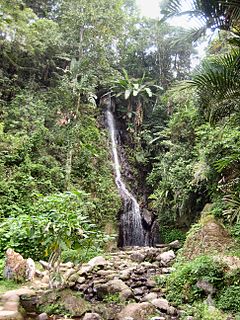
The flora consists of many unique varieties of tropical plants. Blessed with a tropical climate and around 17,000 islands, Indonesia is a nation with the second largest biodiversity in the world. The flora of Indonesia reflects an intermingling of Asian, Australian and the native species. This is due to the geography of Indonesia, located between two continents. The archipelago consists of a variety of regions from the tropical rain forests of the northern lowlands and the seasonal forests of the southern lowlands through the hill and mountain vegetation, to subalpine shrub vegetation. Having the second longest shoreline in the world, Indonesia also has many regions of swamps and coastal vegetation. Combined together, these all give rise to a huge vegetational biodiversity. There are about 28,000 species of flowering plants in Indonesia, consisting 2500 different kinds of orchids, 6000 traditional medicinal plants used as Jamu., 122 species of bamboo, over 350 species of rattan and 400 species of Dipterocarpus, including ebony, sandalwood and teakwood. Indonesia is also home to some unusual species such as carnivorous plants. One exceptional species is known as Rafflesia arnoldi, named after Sir Thomas Stamford Raffles and Dr. Thomas Arnold, who discovered the flower in the depths of Bengkulu, southwest Sumatra. This parasitic plant has a large flower, does not produce leaves and grow on a certain liana on the rain forest floor. Another unusual plant is Amorphophallus titanum from Sumatra. Numerous species of insect trapping pitcher plants can also be found in Borneo, Sumatra, and other islands of the Indonesian archipelago.

Pieter B. Pelser is a Lecturer in Plant Systematics and the curator of the herbarium at the University of Canterbury in Christchurch, New Zealand. One research interest is the evolutionary history of the tribe Senecioneae, one of the largest tribes in the largest family of flowering plants. He wrote the most recent attempt to define and delimit this tribe and its problematic founding species Senecio. He also studies insects that eat these plants (Longitarsus) which contain pyrrolizidine alkaloids and what makes them choose which plants they eat.
Rafflesia philippensis is a parasitic plant species of the Rafflesiaceae family that was named by Francisco Manuel Blanco in his Flora de Filipinas in 1845. The species is known only from a mountain located between the provinces of Laguna and Quezon, Luzon where it was first discovered. Its plant host is Tetrastigma pisicarpum. This species went unnoticed since its first description by Blanco but was rediscovered in 2003 by members of the Tanggol Kalikasan, a local environment conservation group in Quezon province who first saw and photographed the open flower of this species. It was brought to the attention of Manuel S. Enverga University (MSEUF), who formed a team composed of students and faculty to document the newly discovered Rafflesia species.
Rafflesia baletei is a parasitic plant species of the genus Rafflesia. It is endemic to the Philippines.
Rafflesia leonardi is a parasitic plant species of the genus Rafflesia. It is endemic to the Philippines. R. leonardi is the fourth Rafflesia species found in Luzon and the eighth from the Philippines. It is called ngaratngat by the local Agta tribesmen.
Rafflesia manillana is a parasitic plant species of the genus Rafflesia. It is endemic to the Philippines.

Rafflesia schadenbergiana is a parasitic plant species of the genus Rafflesia. Known as "bó-o" to the Bagobo tribe and "kolon busaw" to the Higaonon tribe of Bukidnon, it has the largest flower among the Rafflesia species found in the Philippines with a diameter ranging from 52-80 centimeters. It has also the second largest flower in the genus after R. arnoldii.

Rafflesia speciosa is a parasitic plant species of the genus Rafflesia. It is endemic to the Philippine island of Panay. R. speciosa is the third Rafflesia species documented to exist in the Philippines, after R. manillana and R. schadenbergiana. It belongs to the medium-sized Rafflesia. The species was named by Julie Barcelona and Edwino Fernando.
Rafflesia cantleyi is a parasitic plant species of the genus Rafflesia. It can be found in Peninsular Malaysia and Pulau Tioman, an island off the east coast of Peninsular Malaysia. This species is almost identical to R. hasseltii, except for the number of warts on the perigone lobes of the two species. Another distinctive feature of R. cantleyi is its ability to form flowers on the aerial portions of its host Tetrastigma.
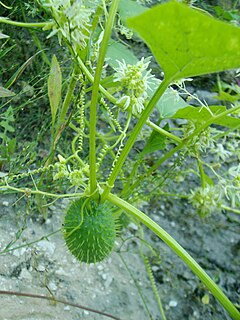
Echinocystis is a monotypic genus in the gourd family, Cucurbitaceae. The sole species is E. lobata, commonly called wild cucumber, prickly cucumber or bur cucumber. It is an annual, sprawling plant that is native to North America.

Sibalom Natural Park is a 5,511.47-hectare (13,619.1-acre) protected area in the Philippines on the island of Panay in the municipality of Sibalom, Antique. It was proclaimed a natural park on 23 April 2000. It is considered as one of the last remaining lowland rainforests on Panay.

Rafflesia verrucosa was first identified and characterized during a small mammal survey of Mt. Kampalili in eastern Mindanao in 2010. R. verrucosa is the tenth species of Rafflesia found in the Philippines. Rafflesia species have rare and unusual flowers known for their large size and pungent smell. Some plant enthusiasts like Frits W. Went have gone to extreme measures to see these plants in bloom. Went detailed his search for Rafflesia saying,
"I had heard, when I was in Java many years ago, that Rafflesia were to be found on an offshore island named Nusah Kembangan. This was in 1929, when it was a penal colony for major criminals. My driver on this occasion was a convicted murderer, and my guide was serving time for cannibalism."

Caladenia lobata, commonly known as the butterfly orchid, is a species of orchid endemic to the south-west of Western Australia. It has a single, hairy leaf and one or two greenish-yellow flowers with red markings which have a labellum which vibrates in the slightest breeze.
Julie F. Barcelona is a Filipina botanist, working as Research Associate at University of Canterbury.
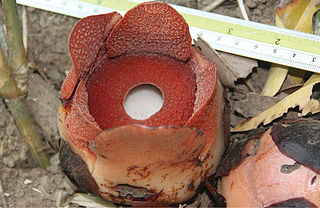
Rafflesia consueloae is a parasitic plant species of the genus Rafflesia endemic to the island of Luzon in the Philippines. It is the smallest species of the genus Rafflesia.












